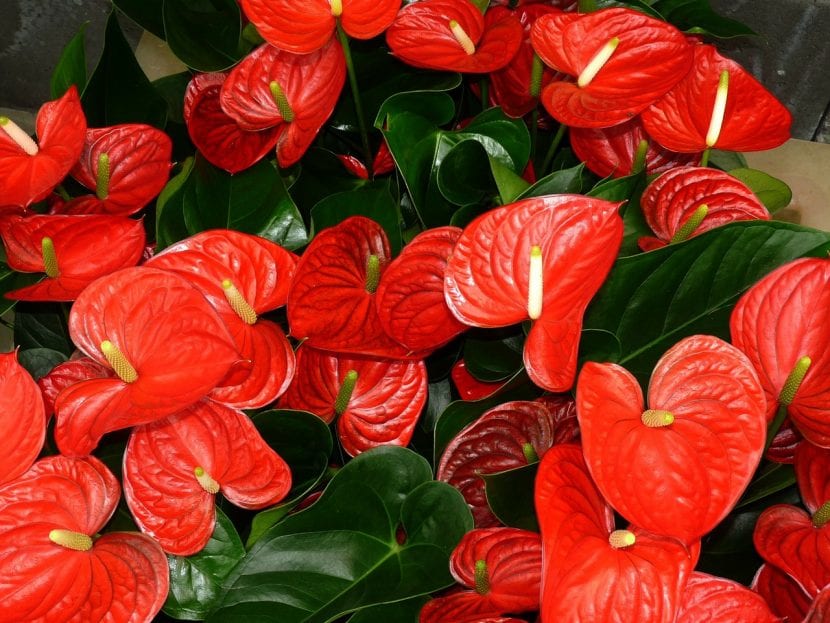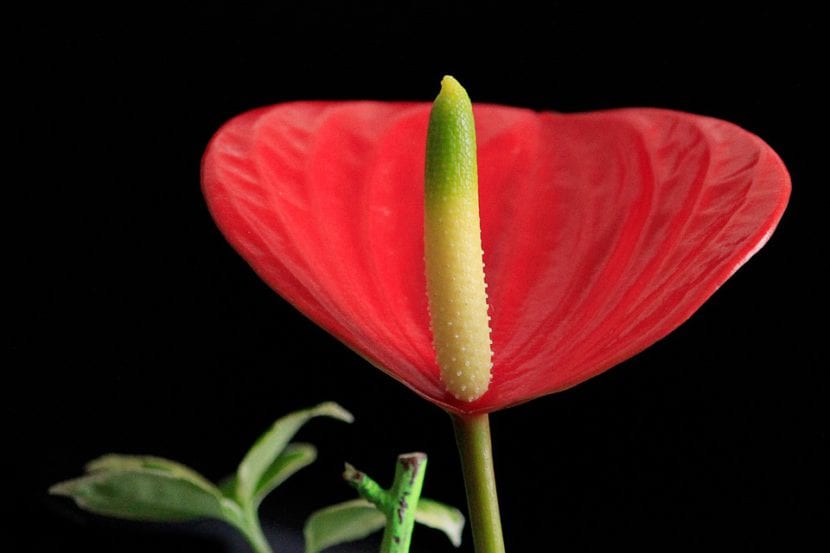
Why does the anthurium not bloom? This magnificent shrub, which is normally sold as a houseplant, has a maintenance that is not always easy, since it needs high humidity to develop, something that often leads us to make the mistake that it has to be sprayed. its leaves daily.
Also, being native to tropical rainforests, where temperatures are mild all year round, you might think that heating your home will benefit you. But that ... is not good for him either. So what do we have to do to get it back to producing its flowers?
The anthurium is a shrub that can reach, in its natural state, a height of around one meter, being the usual thing to stay between 60 and 80 centimeters. What is most striking are undoubtedly its petals, which are actually bracts (modified leaves) generally red in color, although it can be white, pink, purple or yellowish depending on the species.
With this in mind, it is not uncommon for us to worry that it will not flourish. What are we doing so that it does not dare to produce its flowers, and what must we change so that it does? Well, the following:
We haven't transplanted it in a long time

All the plants that are grown in pots depend a lot on the care we give them. And is that the nutrients in the substrate are used up from almost the first day they were planted in said container. This also entails, as is normal, the growth of the roots, which occupy all the space they have available ... until a time comes when they cannot continue to grow.
This is when the growth rate slows down or stops, when there are no more nutrients left, and when the anthurium not only stops blooming but, as if that were not enough, begins to weaken.
What to do?
Transplant it of course, in spring, and every 2 or 3 years. A wider pot with holes of new acidic plant substrate that drains well (like this one they sell here) will help it to continue to develop, and to produce its magnificent flowers again.
Has too much (ambient) humidity

That anthurium needs high humidity is very true; not in vain, its natural habitat is the tropical rainforests. But when it is grown indoors we usually have a problem: in homes, the environment can be dry the further we live from the coast, or humid / very humid the closer we live.
What happens is that in any case what is done a lot is to pulverize its leaves very often, and this can rot themas they cannot absorb water directly. In fact, when it rains, the pores on the surface remain closed, and if that water does not dry quickly, the cells begin to die ... which is when the typical yellow or brown spot will begin to appear that will spread quickly as the sheet dries.
What to do?
The first thing is to find out what the humidity of the house is. For it, we can buy a digital thermometer that also marks the percentage of humidity (get it here) or a hygrometer; But yes, if we live near the coast it will not be necessary to do anything, because we will already know that it is very high, and it is even likely that we will have to deal with it (black spots that appear on the walls of the house, for example).
Once we know which one there is, we can take these measures:
- Percentage of 50% or higher: you don't have to do anything 🙂. With that humidity the anthurium will be fine.
- Percentage less than 50%: in this case it is advisable to put glasses with water around it, put it near other plants, or buy a humidifier (for sale here).
It has been watered in excess / little

Water is essential for life, but the amount that a living being needs will depend not only on itself (size, resistance to drought, etc.) but also on the conditions of the place where it lives. Therefore, an anthurium in Mallorca will need much more than one that lives in Galicia for example, because on the Balearic island it rains much less than in the peninsular community, especially in summer, which is when temperatures easily reach 38ºC coinciding with the dry season.
And it is that no, not everything focuses on the rains. To have a good irrigation schedule it is very important to know, more or less, the climate that we have in the area, and keep in mind that the warmer and drier it is, the more we will have to water. But, how to know if we have watered a lot or a little? For the symptoms that the plant will show:
- Lack of irrigation:
- Dry leaf tips, starting with the new ones normally.
- Abortion of the flowers, if any.
- Sad general appearance.
- The soil will be very dry (depending on the brand of substrate, it may even have become a 'block' of soil).
- Excess irrigation:
- Yellowing of the leaves.
- Leaf fall.
- Root suffocation, or what comes to the same thing, rotten roots.
- Appearance of fungi.
What to do?
It will depend on the problem. If it is lack of irrigationWhat we will do is take the pot and put it in a bucket or basin with water for about thirty minutes, until we see that all the earth has been soaked.
However if it is excess watering, you have to cut the brown / black parts, remove it from the pot and wrap the earth bread with several layers of absorbent paper. Then, we leave it like that for several days, in a dry place protected from light. After about four days, or once the soil has lost moisture, we plant it again but in a new pot, and we treat it with fungicide. We will water again after two or three more days.
We will use rainwater or lime-free.
Need fertilizer

As important as water is compost, or 'food'. For the anthurium to flourish needs to be credited regularly during spring and summer, otherwise sooner or later it will run out of nutrients in the substrate. And that, as we saw in the transplant section, is not good.
But what are the ones that will help you flourish? Well, they are all very necessary, but it is true that there are some that are used the most for the production of flowers, which are phosphorus (P) and potassium (K). Of course, nitrogen (N) must have a low percentage, otherwise we will have many leaves, a lot of growth, but flowers ... few or none.
What to do?
Buy a fertilizer rich in phosphorus and potassium, but low in nitrogen, or one for flowering plants (on sale here), and follow their instructions to the letter. Not by adding more quantity we will have more flowers; What is more, if we do not pay attention to what we are told on the product packaging, the roots could burn and the plant could die.
Don't have enough light

Anthurium does not flourish in places that are rather dark. It is true that he lives in tropical jungles, in the shade of other tall plants, but as far as he is, enough light reaches for him to flourish. For this reason, if we have it in a dark bathroom, for example, we will not see flowers.
So, no matter how good it looks in that room, if it only flourished once - when we bought it - and it hasn't done it again, you have to think about moving it around.
What to do?
Move it to a brighter room, of course. An interior patio, a living room with windows facing east (which is where sale the sun), or any other place where, ourselves, we can see well during the day without having to light a lamp.
Be careful: never put it next to the window or in direct sunlight, as we will cause burns.
It is not its flowering season / it is young

Although two different reasons, as the measures to be taken are the same, I have preferred to put them together. In the first case, you have to know that anthurium blooms, if all is well, during spring and summer (or all year round if the climate is typical hot and humid tropical). For this reason, if there are only mild / warm temperatures in our area for a few months, it will only flower during that time.
On the other hand, if the plant is young, it will not flower either. The specimens sold in the nurseries are already adult enough to flower, but if we get them from seed we will have to wait an average of 4 years to see her flowers for the first time.
What to do?
Well, we can't do much more than wait and keep taking care of it good 🙂.
We hope you have been able to find the "problem" with your anthurium and see its flowers again soon.
Thanks for the report. Very explicit.
Hi Karina.
Thank you very much for following us and commenting 🙂
Regards!
The article is excellent, but it lacks images that refer to the literature or aspect of which they speak.